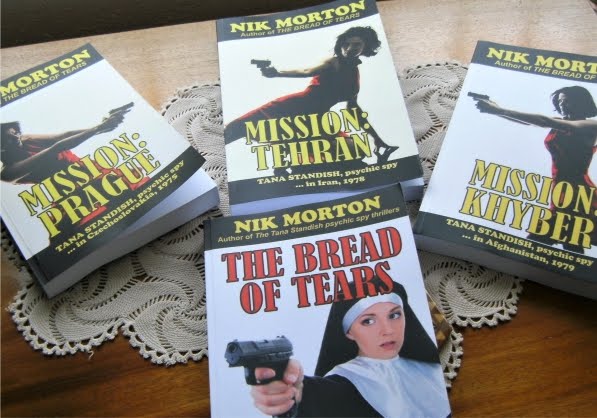The official companion to the
TV series, Murdoch Mysteries (2015)
is a lavish reasonably priced hardback with dozens of colour photographs. Ideal
for any fan to own. The authors Michelle Ricci and Mir Bahmanyar were given
much assistance from the cast and crew; this book covers series 1 thru 8, so
there will be spoilers. As usual, Titan Books gives us an excellent book in every respect.
There’s a foreword by the
author of the books, Maureen Jennings, enjoying how her characters are being
brought to life. The introduction is by Christina Jennings (no relation!),
Executive Producer and Chairman & CEO of Shaftesbury films, explaining that
some twelve years ago Maureen Jennings’ publisher sent her the books to read, and
she decided to adapt three books as TV movies. Although the adaptations were
faithful to the books, there was one exception; the invention of another
character outside her comfort zone, just like Murdoch, so coroner Julia Ogden
was created. The films were successful and the broadcaster was keen for a continuing
series to be produced. It was decided to depart from the darker tone of the
movies, ‘more Jules Verne, less Dickens’, and introduce steampunk and humour,
with knowing nods to the future, and of course there would be romance. Happily,
the team assembled provided all that, and more, from good writing, brilliant
Victorian and Edwardian sets, to excellent acting.
There are fascinating
insights into the characters, Victorian Toronto, and the inventions of the time
depicted. The Toronto police were formed
in 1859. By the time of the start of the series (1895) the police have all-night
patrols, a mounted unit for outlying areas and to control speeding horses!
Bicycles for patrols were introduced in 1894, and as we know Murdoch was a keen
cyclist. Up to the early 1890s, the police were also the main source of ‘social
services’, until humane societies came on the scene.
We are presented with
blueprints of Police Station No.4 and the morgue. And Prime Minister Stephen
Harper appeared as a desk sergeant. We’re given an insight into the music, too,
which is an important aspect of the series, helping to create the mood.
Yannick Bisson (Murdoch) does
not, has never, and will never wear mascara or any eye makeup, we are told.
Those distinctive eyelashes have been with him since he was born! It could have
been a daunting prospect to audition for a character that had already appeared
in three TV movies. However, executive producer Val Coons had declared he was
looking for someone different, He read about three times to get the part –
which he has definitely claimed as his own over eight series.
Considerable coverage is
given to the costumes, which again have to reflect not only the period but the
characters. The offices, and all the other sets, are painstakingly created to
evoke that period feel.
All the main characters are
covered in some depth – Julia Ogden, Constable George Crabtree, Inspector
Thomas Brackenreid, and Doctor Emily Grace. Then we meet their friends and
foes, too, all of whom grow in depth as the series moves forward, not least
Chief Constable Percival Giles, tycoon James Pendrick, spymaster Terrence
Meyers and arch-enemy James Gillies, among many others.
There’s an intriguing
blueprint of Pendrick’s electric car, ‘The Pendrick Bullet’, which took four
months to perfect instead of the usual two weeks for inventive props. And it
worked, as shown, with the actors in the cab!
And of course we can’t forget
the many historical figures who appear in the series: Prince Alfred, Alexander
Graham Bell, Winston Churchill, Arthur Conan Doyle, Thomas Edison, Henry Ford,
Harry Houdini, Jack London, ‘Bat’ Masterson, Annie Oakley, Theodore Roosevelt, H.G.
Wells, and many more fascinating cameos.
Lastly, we’re given a
year-by-year account of the attraction, disappointments, travails and on-off courtship
of William Murdoch and Julia Ogden.
Every year, the writing staff
meet a number of months before the next
series goes into production and they develop stories and ideas. We’re given a
fascinating overview of how a storyline comes together – the 100th
episode, in fact – and how the writers lay out a particular story with all the
specifics – the beats – of what happen in each scene. They have to attend to
logical progression, clues, red herrings, humorous interludes. The beat sheet
is the guide; this becomes 15 pages of prose, scenes in paragraphs. It’s then
read and revised and approved and then it becomes a 50-minute script.
As the back-cover blurb says,
this is a treasure trove for fans of the series.


























No comments:
Post a Comment